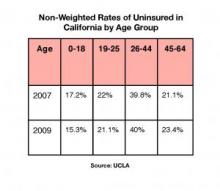Boomers Systematically Lost Insurance

A new report by UCLA researchers paints a sobering picture of middle-aged Californians who systematically lost health insurance coverage during the peak years of the Great Recession, and provides scant evidence they regained it as the economy revived.
The report by the UCLA Center for Health Policy Research concluded that the number of uninsured statewide rose more than 10% between 2007 and 2009, reaching 7.1 million, or roughly 20% of California's residents. Those between the ages of 45 and 64 were affected disproportionately, according to data from the California Health Interview Study, the huge pool of data UCLA has compiled for its research reports.
The latest study broke down California's counties into four categories, ranging in how severely they were impacted by the recession during 2007, which marked the start of the economic downturn, and 2009, which is considered the Great Recession's peak.
Although many of the age groups in these counties experienced a nominal loss in insurance during those years, the level of coverage for some actually increased as safety net programs such as Medi-Cal or Healthy Families expanded their roles as family incomes dropped.
But among those age 45-64, the level of uninsured remained steady only in the counties that suffered the smallest impact from the Great Recession. They rose in all the other categories. In the counties most impacted by the recession, the level of uninsured between the ages of 45 and 64 rose by more than 30%. That's despite the fact that virtually every other age group in the highly impacted counties saw their rates of uninsured decline.
“Whether because mid-career workers are viewed as too expensive or because there is a deeper bias against older workers, the data suggests the ax is first to fall on the Baby Boom generation,” said Shana Alex Lavarreda, the study's lead author and the UCLA center's director of health insurance studies.
Moreover, the levels of full-time employment shrunk dramatically in all of the counties, from well above 60% in each category to below 50%. Part-time workers also increased in three of the four county categories.
Lavarreda noted that initial data for 2011 and 2012 suggested that this trend continued to accelerate, although specific numbers were not yet available.
Since few employers offer healthcare coverage to less than full-time workers, it could be inferred that California's labor market underwent a systematic change where the majority of workers should no longer expect job-based healthcare coverage.
“We have seen it in multiple cycles now – the number of uninsured goes up during recessions, and it never approaches the same amount (of insured) during the recovery,” said Anthony Wright, executive director of Health Access California and a member of the Payers & Providers editorial board.
The UCLA report suggested that the loss of coverage was so profound during the Great Recession that the number of Californians believed to be eligible for Medi-Cal expansion as part of the Affordable Care Act may have been undercounted.
Specific numbers of potential new Medi-Cal enrollees were not provided in the new report. Lavarreda declined to make specific projections in an interview on Wednesday.
Research performed earlier this year by UC Berkeley concluded that as many as 1.4 million Californians could be eligible for Medi-Cal under the expansion, which raises income eligibility to 138% of the federal poverty level.
Another 2.5 million Californians that are currently eligible for Medi-Cal have yet to be enrolled.
The Low Income Health Insurance Program, which expanded Medi-Cal enrollment through a federal waiver, has already enrolled more than 628,000 Californians as of May, the most recent month for which data was available from the Department of Health Care Services.
A report issued by UCLA and the Blue Shield of California Foundation last September projected LIHP enrollment would reach only 512,000 by the end of 2013.
That the LIHP program exceeded its projections by a wide margin suggests to Lavarreda that there may be a significant pent-up demand for coverage both through Medi-Cal and the Covered California health insurance exchange.
UCLA is working on a report regarding projected commercial and Medi-Cal uptake in 2014. Although that data has yet to be published, Lavarreda noted that both demand for enrollment and uptake will almost certainly be adjusted upward from prior estimates.
“I think the forecasts have been very conservative regarding uptake and rampup under the ACA,” she said.
Given that millions of Californians who will obtain insurance coverage next year may have gone as long as seven years without it, the initial strain on providers is expected to be considerable.
“Provider networks are aware of the tsunami that is coming, and they are preparing for it,” Lavarreda said.
Wright also believes that providers will encounter a very strong demand for services next year.
“The trends of the those who have been uninsured has built this up,” he said. “The ACA will have helped this out, but I don't think people realize how much more the rate of uninsured would have risen if we had done nothing.”






